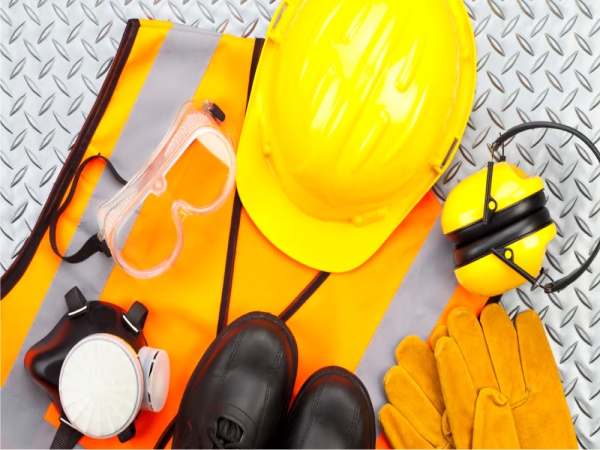
Fall Protection
Factory protection equipment refers to a range of safety devices, tools, systems, and personal protective equipment (PPE) designed to safeguard workers, machinery, equipment, and facilities within industrial settings like factories. These protective measures aim to prevent accidents, injuries, occupational hazards, and potential damage to property and ensure compliance with safety regulations and standards. Here are some common types of factory protection equipment
We stand for quality, safety & credibility, so you could be trust us fully about architectural working process.
Personal Protective Equipment (PPE):
- Safety Helmets: Protects the head from falling objects, impacts, and electrical hazards.
- Safety Glasses/Goggles: Shields eyes from debris, chemicals, dust, and flying particles.
- Ear Plugs/Muffs: Reduces exposure to excessive noise levels and prevents hearing damage.
- Safety Shoes/Boots: Provides foot protection against heavy objects, sharp materials, and electrical hazards.
- Gloves: Protects hands from cuts, abrasions, chemicals, and thermal hazards.
Safety Guards and Barriers:
- Machine Guards: Shields machinery components like gears, belts, and moving parts to prevent accidental contact and injuries.
- Safety Barriers: Establishes physical barriers to restrict access to hazardous areas, machinery, or equipment.
- Fencing and Enclosures: Encloses specific areas within the factory to prevent unauthorized access and protect workers from potential hazards.
Fire Safety Equipment:
- Fire Extinguishers: Portable devices used to extinguish small fires and prevent fire spread.
- Smoke Detectors and Alarms: Detects smoke and triggers alarms to alert occupants and initiate evacuation procedures.
- Fire Suppression Systems: Automatic sprinkler systems, fire hoses, and hydrants designed to control and extinguish fires in various factory areas.
Emergency Response Equipment:
- First Aid Kits: Contains essential supplies and medications to treat injuries and medical emergencies.
- Eye Wash Stations: Provides immediate flushing of eyes exposed to chemicals, dust, or foreign objects.
- Emergency Showers: Delivers water to rinse off workers exposed to chemicals, contaminants, or hazardous materials.
Ventilation and Exhaust Systems:
- Ventilation Fans: Improves indoor air quality by circulating fresh air and removing contaminants, fumes, and airborne particles.
- Dust Collectors: Captures and collects dust, particles, and pollutants generated during manufacturing processes to maintain a clean and safe working environment.
Safety Signage and Labels:
- Warning Signs: Indicates hazardous areas, machinery, or operations requiring caution or specific safety measures.
- Instructional Labels: Provides guidance, instructions, and safety information related to equipment operation, maintenance, and emergency procedures.
Lockout/Tagout Devices:
- Lockout Devices: Locks and secures machinery, equipment, or power sources during maintenance, repair, or servicing to prevent accidental startup or operation.
- Tagout Tags: Attaches warning tags to locked-out equipment, indicating the reason for lockout/tagout procedures and preventing unauthorized use.
Electrical Safety Equipment:
- Insulated Tools: Provides protection against electrical shocks when working on or near energized electrical systems and equipment.
- Ground Fault Circuit Interrupters (GFCIs): Detects electrical faults and interrupts the circuit to prevent electric shocks and electrocution.
Implementing and maintaining proper factory protection equipment and safety measures are essential to create a secure and healthy working environment, minimize risks, comply with regulatory requirements, and protect both employees and assets within industrial facilities.

Factory protection equipment
Factory protection equipment encompasses various safety devices, tools, systems, and personal protective gear (PPE) tailored to protect workers, machinery, equipment, and premises in industrial environments such as factories.
- Safety Helmets/Hard Hats
- Safety Glasses/Goggles
- Safety Shoes/Boots
- Protective Gloves
- Machine Guards
Various materials are utilized in house building, each chosen based on factors like location, design preferences, climate considerations, budget constraints, and local building regulations. Wood remains a fundamental choice, frequently employed for structural framing, flooring, roofing, and finishes, with options ranging from softwoods like pine to hardwoods such as oak. Concrete plays a pivotal role, especially for foundations, slabs, walls, and other structural elements. Both brick and stone offer durability and aesthetic appeal, finding their place in walls, facades, and decorative aspects of a home. Steel emerges as a stalwart choice for structural framing, beams, columns, and roofing, imparting strength and resilience.
Welding services are critical for fabricating structures, repairing equipment, and creating intricate assemblies. Professionals in this field must have expertise in selecting the appropriate welding method, materials, and techniques based on the specific requirements of a project. Safety measures, including protective equipment and ensuring proper ventilation, are paramount during welding processes due to the inherent risks associated with high temperatures, fumes, and potential hazards.
Again, for specific information about Avionics Safety’s offerings or services related to welding, it would be advisable to contact the company directly or consult their official resources.
The amount of time you can save on a renovation project depends on various factors, including the scope of work, the complexity of the project, your level of involvement, and the resources available. Here are some considerations that can influence the time saved:

